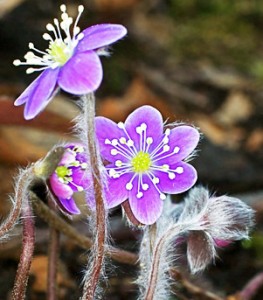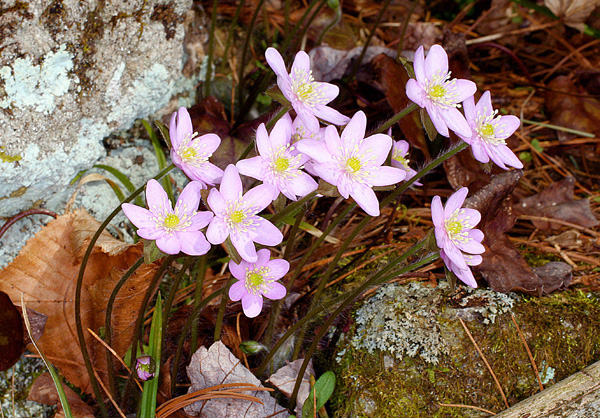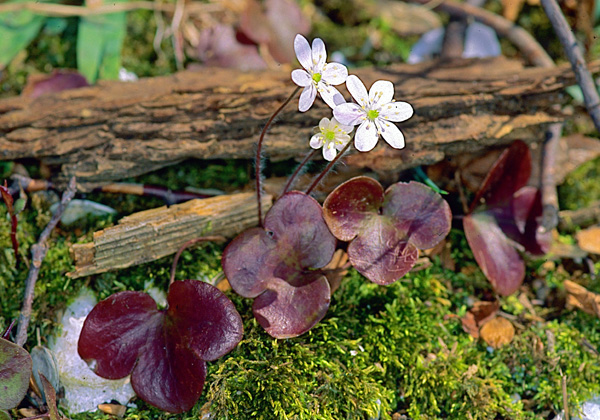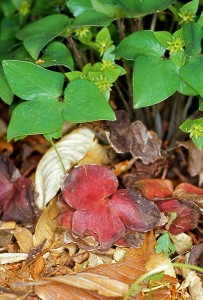Hepatica: A Pretty Plant Deserving of a Prettier Name
Posted in Around the Garden on April 5 2013, by Carol Gracie
After spending nearly three decades at NYBG, and working much of that time in South American rainforests with her husband, Scott A. Mori, Carol Gracie has returned to one of her first botanical interests in retirement–local wildflowers. She is the author of Spring Wildflowers of the Northeast: A Natural History and coauthor (with Steve Clemants) of Wildflowers in the Field and Forest: A Field Guide to the Northeastern United States.

Hepatica is the first “true” wildflower (that is, other than the rather unusual-flowered skunk cabbage) to bloom in the tri-state region. Its lovely flowers are a cheerful indicator that spring has really begun, but they can be surprisingly difficult to spot among the dull brown leaf litter. The flowers range in shades of pink, lavender, purple, and white, but they are small and low growing—plus they only open on sunny days. This strategy serves to conserve the flower’s pollen for days when its pollinators (usually small native bees) are likely to be flying.
It may be easier to find the distinctive leaves of hepatica; they are three-lobed, leathery, and often a deep burgundy color at this time of year. Hepatica retains its leaves for a full year, allowing the plant to photosynthesize on mild winter days and thus get a jump-start on the season. The appearance of the leaves is what has given this plant its somewhat unattractive common names, hepatica and liverleaf, both references to the imagined similarity of the leaves to a human liver. This fancied resemblance almost led to the plant’s demise during the 19th century.

At that time herbalists, both here and in Europe, deemed the plant useful for treating liver ailments. This belief was based on the ancient “Doctrine of Signatures,” a system in which the morphology of the plant, whether shape, color, or growth form, signified what illnesses the plant might be used to treat. Literally tons of hepatica leaves were harvested, primarily in the Appalachian region, and processed into patent medicines—something we would now refer to as “snake oil.” More recent studies of hepatica’s properties have shown it to have no medicinal efficacy.

Another adaptation facilitating early season bloom is the profusion of dense, soft hairs that cover the flower stalk and protective bracts. The hairs serve to insulate the plant against cold temperatures and drying winds. Three fuzzy bracts beneath the sepals enclose and protect the flower in bud. The colorful floral parts are not petals, but modified sepals that have assumed the role of attraction that is more commonly played by petals. After the plant has flowered, the old leaves wither, and tender new leaves, also covered with downy hairs, begin to unfold. It is these leaves that produce the carbohydrates to be stored in the underground parts for next year’s early growth.

There are two species of hepatica in eastern North America: one with leaves having three rounded lobes and one with pointed-lobed leaves. At one time they were both considered to be species of the genus Hepatica. However, the scientific name of hepatica has had a long history of changes. Current taxonomy, based on molecular studies places both of our species in the genus Anemone rather than Hepatica, with the round-lobed leaf species being called Anemone americana and the species with pointed-lobed leaves called Anemone acutiloba. By any name, it is a lovely wildflower—so much so that John Burroughs, the famous 19th century American naturalist, said of it, “There are many things left for May, but nothing fairer, if as fair, as the first flower, the hepatica. I find I have never admired the little firstling half enough. When at the maturity of its charms, it is certainly the gem of the woods.”
Read more about hepatica in my book, Spring Wildflowers of the Northeast: A Natural History, available at Shop in the Garden. And be sure to see sharp-lobed hepatica in the new Native Plant Garden during the Grand Opening Weekend, May 3–5, 2013.

